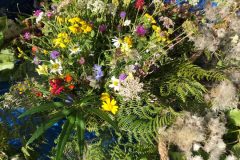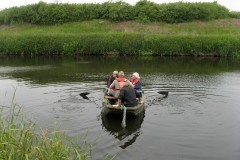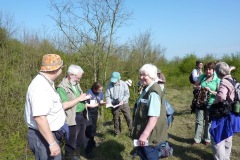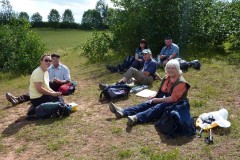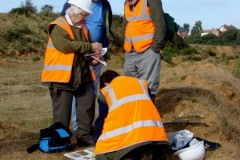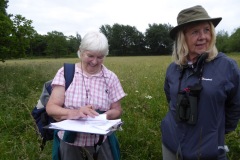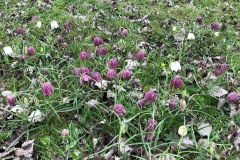This is the Obituary of Mrs Philippa Anne Seccombe who died in September 2021 at the age of 82 It is now April 2022. Why did it take so long to write? Because, to be honest, we have been avoiding it. Why? Perhaps because it was too difficult, too painful, or perhaps because we were waiting for inspiration. How is it ever possible to sum up a lifetime in a few words?
It is Easter Sunday, and today we are going to visit Owston Meadows.
Owston is the reason why we come to be writing this tribute, because this is where the Seccombe family found themselves in the spring of 1974 when Marc Seccombe was serving the Parishes of All Saints Owston and Skellow and St. Michael’s, Carcroft. Because this is the place where ‘Pip’, a young vicar’s wife with four children, saw a girl walking along the Stockbridge Lane with a handful of wildflowers. Because Owston is the place where, in the pasture at the back of the vicarage, the Snake’s-head Fritillaries grow.
It was probably the discovery of this colony of Snake’s-head Fritillaries Fritillaria meliagris in the Glebe Fields in Owston that sparked Pip’s real interest and lifelong passion for Natural History of Doncaster. Her concern for the possible threat to these flowers lead her to the local Museum. One museum volunteer who later became a renown plant-spotter recalls ‘when I was doing voluntary work at Doncaster Museum, 1972-82, the Natural History staff mentioned that a vicar’s wife had found a rare plant and they were going to look at it. At that time I was interested and involved with archaeology and the rare plant did not really register with me’. The discovery lead to the designation of the site as a Local Authority Natural History site and subsequently a Nature Conservancy Council SSSI and Yorkshire Wildlife Trust (YWT) Conservation site.
That initial contact with the Museum brought Pip within the reach of the ‘mycorrhizal mycelium’ of the Doncaster Naturalists’ Society, ‘the Nats’, in the guise of Dr Peter Skidmore and Colin Howes. Like any symbiotic relationship, both parties gained from the association. Pip was introduced to amateurs and experts who all shared their enthusiasm and interest, and who must also have inoculated Pip with the Natural History ‘bug’. In return, Pip volunteered at the Museum. She quickly became involved in local plant recording for the Museum and before the days of computerised distribution mapping, undertook the gargantuan task of ‘hand crafting’ a (5”x 3”) dot-map card for each vascular plant recorded in the Doncaster Metropolitan Borough, painstakingly transferring records from Biological Records Centre species-list cards, several cards for each of the 167 1km squares within the Doncaster region.. Pip joined the Doncaster ‘Nats’ in the 1970s and took an increasingly active role in the society, eventually serving as President between 1995 to 1997 and again from 2002 to 2004 and as the society’s Recorder from 2000 to 2019.
Born in Hertfordshire in 1939, Pip and her younger sister Judy, had quite a fractured and nomadic early life (Pip would probably say ‘exciting’). When she was 5 years old, the family was living in a caravan in Scotland, Pip travelling to school, independently, by train. Not too long after that, their Mum was bringing them up as a single parent, following the marriage break up. Pip had lasting memories of her time in Scotland, especially being befriended by a couple of artists who lived nearby. Both made beautifully detailed paintings in her autograph book, a treasured life-time possession and something she reminisced over in 2020. They also gave Pip’s mum a beautiful chair that still belongs to a Seccombe.
The family moved back down south, and in her late teens, Pip met Marc at the local scout group in Watford, where both were volunteer pack leaders. Their first date was to the Proms in the Albert Hall. At that time, Marc one of very few people to own a car, a Morris 8, and was able to park directly outside the venue.
They married on 17th September 1960 and moved into digs, with live-in landlords. Marc attended Theological College and Pip worked as a Pathology Lab Technician. Tim was born in Barnett in 1962, and once Marc qualified, the family moved north. Jane was born in Nottingham in 1965 and they moved and settled in Doncaster two years later. Robin and then Lucy were born in 1968 and 1970, respectively. During that time, Marc was curate at St. Paul’s in Wheatley, the sister church to St. Mary’s where Pip and Marc ended up as faithful parishioners. In her early days in the parish, Pip helped to set up St Paul’s Play Group in Wheatley in the 1970s. She continued to fully support Marc in his role within the community, up until his retirement from Rossington in the late 1990s.
The Seccombes moved to Owston in 1972. The vicarage was absolutely huge and, over time, every space was filled, including windowsills, always stacked with books, papers and tubs, emptied of margarine and filled with owl pellets and bat poo, for identification purposes, obviously. The garden was massive too, with the addition of a Glebe Field. The location must have been such a draw to Pip, being a remote area of countryside and it probably reignited her childhood interest in natural history and Botany, one of her A level choices two decades earlier.
Pips interests were broad, perhaps initially it was the botany of Owston Meadows that attracted most attention but this quickly widened out into all fields from the ground up (and possibly down!). Fungi, ladybirds, slugs, shieldbugs, slime moulds, lichens, moths, bumble bees, plant galls, wasp and flies to name only a few; all attracted her interest. She also recorded her garden birds for the British Trust for Ornithology. She was a regular supporter of the Don Gorge bat group, intrepidly exploring limestone fissures and tunnels from Levitt Hagg to Nearcliffe Wood in search of winter bat hibernacula. She also took part in the annual summer emergence counts of the Daubenton’s bat nursery site at St Cuthberts Church, Fishlake.
We all learned many things from Pip. Not just identification skills but things such as always having a small sealable container in a pocket for potting-up an odd-looking insect, and never wasting an old unused diary (they make excellent field note books, you know). One friend of the ‘Nats’ described having only met Pip a couple of times but having ‘a lovely memory of bat watching (at Fishlake) and looking at ferns at Cantley Manor many years ago. How knowledgeable and approachable she was. So keen to share her enthusiasm and love of the natural world. It was a joy to learn from her’.
We also learned the need to be more active in our protection of Doncaster’s natural history. The Society Archive contains many examples of Pip putting pen to paper (or finger to keyboard) to set out some particularly excoriating analyses of the shortcomings of the Planning Department of the Local Authority or the ‘Infernal’ Drainage Boards, often in cahoots with people like the late Stephen Warburton of the Yorkshire Wildlife Trust or the Thorne and Hatfield Moors Conservation Forum. Continued lobbying by the Society (and Pip in particular at the Doncaster Biodiversity Action Partnership meetings) played a part in the creation of Planning Ecologist and Biodiversity Officer posts in the Local Authority.
Pip took a role on the YWT Reserves Management Committee and for several years oversaw the YWT reserves at Hopyard Hay Meadow, Fen Carr as well as Owston Meadows. Tricia Haigh remembers Pip as being one of the key people from the ‘Nats’ who helped with the first surveys of the churchyard at Finningley back in 1994 that ‘started us off on the path to managing it as spring and summer meadows’.
Pip and Marc’s combined interests, natural history and film making, lead to a long-standing relationship between the DNS and Doncaster Moviemakers. Pip featured in and in many cases narrated many of Marc’s excellent productions and Marc’s films often had a natural history or musical theme.
Whilst resident at St Michael’s Vicarage, Rossington, Pip hosted and chaired the project team which undertook botanical surveys of local rural churchyards. This exercise resulted in the publication in 1999 of Doncaster Naturalists’ Society’s most ambitious work ‘Doncaster’s Living Churchyards’, Pip and her eldest son Tim editing the accumulated sections, two of which were personal contributions. This monumental survey of Doncaster’s Churchyards was one of Pip’s legacies, as was the encouragement of two Nats members to produce ‘A Year at manor Farm’ and book of nature notes from Sykehouse and Fishlake. Pip stayed in touch with the authors long after they moved from the district. That was typical of Pip, she always continued her contacts with people. She visited ‘Nats’ members such as Bessie Chapman, Dorothy Bramley and David Gagg long after they were unable to attend meetings or outings. She would also make sure that Derek (Honorary Life Member and ‘Nats’ Minutes Secretary for 30 years) always had a square meal whenever he visited! She bought botany books from Hay on Wye (during visits to ‘Elgar Country’ with Marc) as a gift for beginner botanists in the Society.
Pip long had an interest in the special habitats of Thorne and Hatfield Moors. One Nats member recalls ‘I think I first saw Pip outside the Museum when the Nats were gathering to go to Thorne Moors in the 1980s. I remember Pip telling me that she used to drive William Bunting about because he did not have a car. She asked him about the gun he used to carry and was it loaded. Pip said he leant out of the car and shot a road sign as a demonstration’. Pip was one of the volunteers who carried out management of ‘Jack’s Piece’, a relict area of mire which had escaped peat extraction at Lindholme Island in the middle of Hatfield Moors in the 1990s, helping to make glades for nightjar in the birch scrub. Pip continued her involvement with the Moors by acting as Secretary of the Thorne and Hatfield Moors Conservation Forum and then by supporting a campaign to purchase part of Jack’s Piece for conservation in memory of Dr Peter Skidmore. She campaigned for the Peat (Skid) Moor Appeal along with Peter’s widow, Heather and Colin Howes and became an important member of the Lindholme Old Moor Management Committee, acting as Recorder for the group. Paulette and David at the Gomde Buddhist Centre, Lindholme recalled meeting up each Christmas for high tea. ‘Nice memories, we will miss her’. A Buddhist blessing for Pip was even given at a shrine in Tibet.
The Natural History collections at Doncaster Museum benefited from Pip’s efforts as a volunteer there in the 2000s. Under the tutelage of Libby Finney the museum conservator, Pip conserved, re labelled and re pickled the Museums spirit collection and also commenced the immense task of re mounting, cataloguing and photographing the museum’s herbarium sheets. In the words of her family ‘here, she put her interest in Natural History into practise and made a number of special and lasting friendships. Her work included re-preserving around 200 specimens, from cockroaches to snakes and an octopus, discovered in Blackpool in the 1930s. The items had to be carefully removed from jars of formaldehyde and re-pickled in alcohol and water. Pip was once left with a lengthy python wrapped around her arm whilst Libby cleaned the original jar, a large enough replacement was unavailable. Pip was instrumental in preserving a wide variety of collections. Apparently, visitors to the workroom were often surprised at how much work was being done because of the laughter and conversation that continually rang and flowed out’.
Pip’s final project at the Museum was in response to a request by Dr Jim McCormick of Chicago. She tracked down glass plate negatives in the collection of Doncaster Museum taken by the pharmacist, photographer, diatom expert and founder member of the Doncaster Microscopical and Scientific Society, Mathew Henry Stiles FRMS (1846-1935). Pip was also keen to remind the staff at the Museum of the role played by the Doncaster Naturalists’ Society (or rather, it’s predecessor the Doncaster Scientific Society) in establishing a Doncaster Museum in1900 in a small room in the old Guildhall. The first Honorary curator was local doctor Henry Herbert Corbett who, with other members of the Scientific Society, had been pressing for a museum since the Society’s foundation in 1880.
Doncaster’s Natural History Archive and preservation of documents and archives within the new Museum structure was also a key interest in latter years. A specimen of the Snake’s-head Fritillary from Owston Glebe collected by Pip in the early days is in the Doncaster Museum Herbarium and has been on show in the newly opened and re-named ‘Danum Gallery, Library & Museum’
Pip contributed to botanical surveys at a number of Doncaster sites, amongst these were Hyde Park Cemetery, on behalf of the ‘Friends of Hyde Park Cemetery’, hay meadows in the Sykehouse area on behalf of the ‘Carstairs Conservation Trust’ and even travelled by rowing boat across the River Don to record the plants of Crimpsall Island for the Environment Agency. Her records also make up a significant part of Doncaster’s Local Records Centre database both in a personal capacity as ‘Recorder: P.A.S’ or as the Society’s recorder. Pip leaves a true legacy of natural history records that will be invaluable to future generations.
In November 2019 and whilst providing full time care for Marc as his health declined due to Parkinson’s Disease, Pip was diagnosed with bone marrow cancer. Pip had to stand down as Society Recorder and was made an Honorary Life Member. Sadly, Marc died in April 2020 and the Pandemic prevented a proper funeral for Marc. It also restricted visitors for Pip’s for nearly two years but members of the Society kept in touch via cards, letters, phone calls or e-mail messages. Following Marc’s death, Pip found much solace in re- watching Marc’s amazing films. For many, the last time they saw Pip was on a joyful occasional on the 2nd of September 2021, her 82nd Birthday. Pip had suggested that the ‘Nats’ should hold a Garden Bioblitz at her home ‘a stroke of genius on her part’ according to her daughter, Jane. Both Jane and Pip’s younger son, Robin, said afterwards (but unknown to those attending at the time) that Pip had spent the longest time outside and with the largest number of people than any time in the previous two years. The sun shone, wildlife was recorded, photographed, pondered over and then put back under its stone, tea and biscuits were consumed and there was Pip, in the centre of it all, like a Queen Bee, overseeing the activity with her ‘wonderfully cheerful disposition and her lovely smile’. That is how some will choose to remember her ‘sitting in her garden with her sunhat on, surrounded by family and friends talking about the natural world and with cake as an additional extra!’
On the last few visits to see Pip at home she had expressed a wish to have wild flowers around her coffin. As Pip herself said, Marc was ‘rather short-changed’ at his funeral in April 2020 so she wished to have a joint funeral. This was not a morbid conversation, just Pip being practical, as ever. That was the thing with Pip, you could talk about any topic (including politics; she once recalled canvassing for the Liberals in Woodlands around the time of the Jeremy Thorpe affair – which she described an ‘interesting’ experience). Pip died on the 20th September 2021 just over two weeks after her Birthday Bioblitz. The Autumnal season of the funeral presented a challenge when it came to providing bouquet of fresh wildflowers but the ‘Nats’ rose to the occasion and a request for floral donations resulted in marvellous display of seasonal flowers, hips, berries and oak leaves decorated with exquisite jewels of spangle and silk button galls.
We have not just lost a fellow Nats members and naturalist, many have also lost a real friend. ‘Pip was such a genuinely kind and lovely person. We will always remember her gentle humour and the twinkle in her eyes’.
So, as we walk across Owston Meadows, carefully avoiding treading on the sea of cowslips, leaving a trail of footprints in the morning dew, we go to pay homage to the Fritillaries and remember our friend, Pip. ‘Visiting and passing Pip’s meadows, will be a constant celebration of a wonderful person’.
‘What a joy it was to have known and shared so much precious time with Pip. Remember her roaming the fields at Owston, making films with Marc, taking charge of Doncaster Nats meetings, recording the local plants and insects and battling to save corners of the Doncaster countryside’.
Prepared by
Louise Hill and Colin Howes with contributions from Pip’s family and members of the Doncaster Naturalists’ Society.
